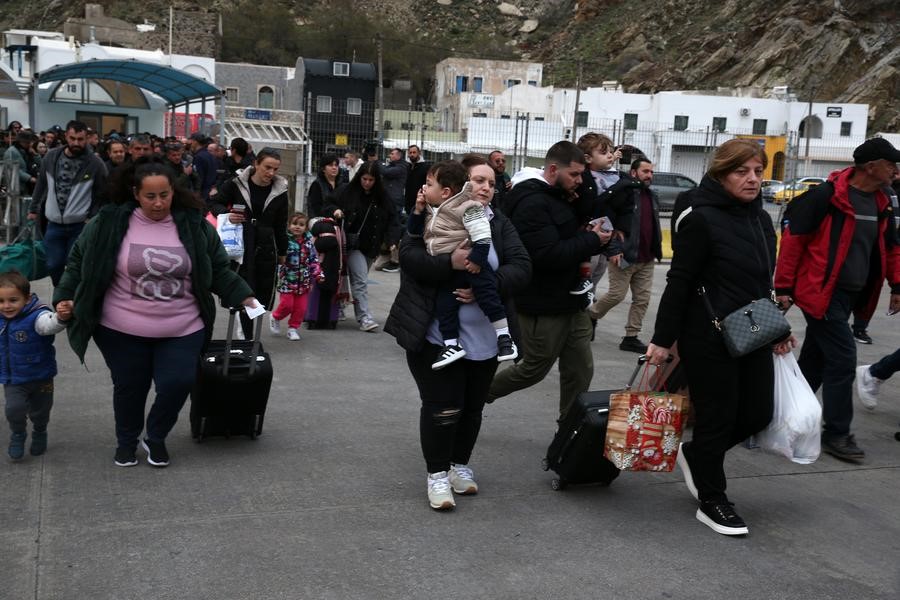




- BRNN
- BRI News
- BRNN News
- Database
Official Documents Polices and Regulations
Inter-government Documents International Cooperation BRI Countries
Business Guide Economic Data BRI Data
Trade
Investment Projects Latest projects
Cases - Content Pool
Santorini, one of the most renowned islands in the Aegean Sea, has recently drawn significant attention due to increased seismic activity over the past few months, which has intensified in the last two weeks. The frequent tremors have raised concerns among residents and authorities, although scientists assure that the situation is being closely monitored.

People walk to board a ferry to leave Santorini after earthquakes shook the island, in Santorini, Greece, on Feb. 4, 2025. (Xinhua/Marios Lolos)
Between Jan. 26 and Feb. 7, 2025, more than 11,700 earthquakes were recorded in the area between Santorini and Amorgos, according to the Seismology Laboratory of the National and Kapodistrian University of Athens. The tremors have been continuous, with residents feeling them on a daily basis. On Feb. 5 alone, over 120 earthquakes were recorded, with 19 exceeding 4.0 on the Richter scale. The strongest tremor that day reached 5.1 magnitude. While the frequency of earthquakes has slightly decreased, experts remain on high alert.
Although Santorini is home to an active volcano, scientists emphasize that the current seismic activity is not linked to volcanic awakening. Professor Efthymios Lekkas, an expert in dynamic tectonics and geology, explained that the faults causing the earthquakes are independent of the volcano and are located at a distance. This means that the likelihood of a volcanic eruption remains extremely low, though it cannot be entirely ruled out. Scientists also do not exclude the possibility of a stronger earthquake, as the phenomenon is still unfolding.
In response, the Greek government, in cooperation with Civil Protection authorities, has declared Santorini and neighboring islands (Amorgos, Ios, and Anafi) in a state of emergency until March 3. Schools on the islands remain closed for the week as a precaution. Authorities have urged residents to avoid old buildings, narrow streets with vulnerable structures, and the island's ports, including Ammoudi and Armeni. Special guidelines have also been issued for visitors, advising them to take safe routes and exercise caution, especially in steep areas with potential landslide risks. Additionally, in the event of a strong earthquake, authorities recommend immediate evacuation from coastal areas due to the risk of minor tsunamis.
The ongoing seismic activity has significantly impacted daily life on Santorini. It is estimated that over 10,000 people have left the island in recent days, either as a safety precaution or due to uncertainty over the situation. Many businesses have scaled down operations, while hotel bookings have declined sharply.
Recognizing the situation, Greek Prime Minister Kyriakos Mitsotakis visited Santorini on Feb. 7, accompanied by the Minister of Climate Crisis and Civil Protection. During his visit, he conducted on-site inspections in affected areas and held meetings with local officials and scientists. A press conference was also held, featuring seismologists, Civil Protection representatives, and local authorities.
The Prime Minister assured that the government will support residents, announcing emergency aid for businesses and workers affected by the crisis. Additionally, he unveiled plans for infrastructure reinforcements, focusing on strengthening public buildings and roads against potential future tremors.
While seismologists cannot predict with certainty how the situation will evolve, the general consensus is that seismic activity is expected to continue for several more weeks. Civil Protection authorities and scientists remain vigilant, urging both residents and visitors to follow safety guidelines. Santorini has endured many challenges throughout its long history. With proper preparation and resilience, the island will once again overcome adversity, preserving its unique beauty and timeless charm.

Tel:86-10-65363107, 86-10-65368220, 86-10-65363106